Recycled Eco-Concretes Containing Fine and/or Coarse Concrete Aggregates. Mechanical Performance
Abstract
:1. Introduction
2. Materials and Methods
2.1. Materials
2.2. Aggregate Characterisation
2.3. Mix Design
2.4. Experimental
2.5. Statistical Analysis
3. Results
3.1. Fresh-State Properties
3.2. Hardened-State Properties
3.2.1. Bulk Density
3.2.2. Compressive Strength
3.2.3. Flexural Strength
3.2.4. Water Penetration under Pressure
4. Conclusions
- -
- Recycled aggregates have greater absorption, as well as lower LA coefficient, density and flakiness index than natural aggregates.
- -
- The coarse recycled fractions (gravel and gravel) and fine (sand) comply with the mechanical, physical and chemical requirements set forth in the current regulations on aggregates for concrete.
- -
- The workability of the concrete is not affected by the addition of the recycled fractions (coarse and/or fine), all of which show a soft consistency.
- -
- The density of the concrete with recycled aggregate is lower than that of the reference concrete in all cases, in the fresh state as well as in the hardened state. The density decreases as the proportion of recycled aggregate in the mix increases, registering density variations of less than 5% in all cases.
- -
- The entrained air content increases slightly as the amount of recycled aggregate increases, although remaining within the usual values for conventional reinforced concrete, not exceeding 1.9% in the mixes with the highest recycled aggregate content.
- -
- The compressive strength of concrete with recycled aggregate is lower than that of the reference mix, with losses of less than 13% in all cases. The greatest losses are recorded in mixes that include a higher percentage (50%) of fine recycled aggregate.
- -
- The flexural behaviour is similar to that recorded in compressive, slightly increasing the maximum loss percentage to 19%. Losses are generally greater in mixes that include a high percentage of recycled aggregate, coarse as well as fine.
- -
- All mixes are therefore suitable for use in class C30/37 structural concrete.
- -
- The expression included in the structural code for estimating the flexural strength is correct, showing values with differences of less than 10% compared to the experimental values for all mixes.
- -
- The penetration depths of water under pressure present great variability, with increases of up to 100%. However, the provisions of the regulations are complied with in all cases.
Author Contributions
Funding
Institutional Review Board Statement
Informed Consent Statement
Data Availability Statement
Conflicts of Interest
List of Abbreviations
| CDW | Construction and demolition waste |
| RCA | Recycled concrete aggregate |
| CS-F | Natural sand |
| CS-M | Natural gravel—medium |
| CS-C | Natural gravel—coarse |
| RCF | Recycled sand |
| RCG | Recycled gravel—medium |
| RCC | Recycled gravel—coarse |
References
- Comission, E. Waste Statistics. 2020. Available online: https://ec.europa.eu/eurostat/statistics-explained/index.php?title=Waste_statistics (accessed on 4 May 2024).
- Ürge-Vorsatz, D.; Novikova, A. Potentials and costs of carbon dioxide mitigation in the world’s buildings. Energy Policy 2008, 36, 642–661. [Google Scholar] [CrossRef]
- Peng, C. Calculation of a building’s life cycle carbon emissions based on Ecotect and building information modeling. J. Clean. Prod. 2016, 112, 453–465. [Google Scholar] [CrossRef]
- Zhang, Z.; Wang, B. Research on the life-cycle CO2 emission of China’s construction sector. Energy Build. 2016, 112, 244–255. [Google Scholar] [CrossRef]
- Zhao, M.-Z.; Wang, Y.-Y.; Lehman, D.E.; Geng, Y.; Roeder, C.W. Response and modeling of axially-loaded concrete-filled steel columns with recycled coarse and fine aggregate. Eng. Struct. 2021, 234, 111733. [Google Scholar] [CrossRef]
- Katerusha, D. Investigation of the optimal price for recycled aggregate concrete—An experimental approach. J. Clean. Prod. 2022, 365, 132857. [Google Scholar] [CrossRef]
- Algourdin, N.; Pliya, P.; Beaucour, A.L.; Noumowé, A.; di Coste, D. Effect of fine and coarse recycled aggregates on high-temperature behaviour and residual properties of concrete. Constr. Build. Mater. 2022, 341, 127847. [Google Scholar] [CrossRef]
- Wang, B.; Yan, L.; Fu, Q.; Kasal, B. A Comprehensive Review on Recycled Aggregate and Recycled Aggregate Concrete. Resour. Conserv. Recycl. 2021, 171, 105565. [Google Scholar] [CrossRef]
- Group, F. Global Construction Aggregates—Demand and Sales Forecasts, Market Share, Market Size, Market Leaders; Freedonia Group: Cleveland, OH, USA, 2016. [Google Scholar]
- Da, S.; Le Billon, P. Sand mining: Stopping the grind of unregulated supply chains. Extr. Ind. Soc. 2022, 10, 101070. [Google Scholar] [CrossRef]
- AS 1141.62/HB 155:2002; Guide to the Use of Recycled Concrete and Masonry Materials. Commonwealth Scientific and Industrial Research Organisation: Canberra, Australia, 2002.
- GB/T-25177; Recycled Coarse Aggregate for Concrete. China Academy of Building Research: Beijing, China, 2010.
- KS-F-2573; Recycled Aggregates for Concrete. Korean Standards and Certification: Seoul, Republic of Korea, 2023.
- CS-3:2013/HKBD 2009/WBTC-No. 12; Aggregates for Concrete. Civil Engineering and Development Department: Hong Kong, China, 2016.
- JIS A 5021; Recycled Aggregates for Concrete—Class H. Japanese Industrial Standard: Tokyo, Japan, 2018.
- JIS A 5022; Recycled Aggregate Concrete—Class M. Japanese Industrial Standard: Tokyo, Japan, 2018.
- >JIS A 5023; Recycled Concrete Using Recycled Aggregate—Class L. Japanese Industrial Standard: Tokyo, Japan, 2022.
- PTV 406-2003; Recycled Granulates. Aggregates of Concrete Debris, Mixed Debris, Masonry Debris and Asphalt Debris. Impartial Control Body for Construction Products: Brussels, Belgium, 2003.
- NBN B 15-001; Concrete—Specification, Performance, Production and Conformity—National Supplement to NBN EN 206. Belgian Standards: Brussels, Belgium, 2012.
- DIN 4226-101; DAfStb; Aggregates for Concrete and Mortar—Part 100: Recycled Aggregates. German Institute for Standardization: Berlin, Germany, 2017.
- NTC-2008; Technical Standard for Constructions. Ministry of Infrastructures and Transport: Rome, Italy, 2008.
- DS 2426/DCA No. 34; Concrete—Materials—Rules for Application of EN 206-1. Dansk Standard: Copenhage, Denmark, 2011.
- NEN-5905; Aggregates for Concrete. Royal Netherlands Standardization Institute: Delft, The Netherlands, 2005.
- E 471-2009; Guide for the Use of Coarse Recycled Aggregates in Concrete. National Laboratory of Civil Engineering: Lisbon, Portugal, 2009.
- MB 2030; Recycling Concrete. Swiss Association of Engineers and Architects: Zürich, Switzerland, 2010.
- BS 8500-2; Concrete. Complementary British Standard to BS EN 206. Specification for Constituent Materials and Concrete. British Standards: London, UK, 2019.
- NF P18-545; Aggregates—Elements of Definition, Conformity and Coding. French Standardization Association: Paris, France, 2021.
- Structural Code; Ministry of Transport Mobility and Urban Agenda: Madrid, Spain, 2021; p. 1789.
- EN 206:2013+A2:2021/1M:2022; Concrete. Specification, Performance, Production and Conformity. Standardization, E.C.f: Brussels, Belgium, 2022; p. 142.
- NBR 15116; Recycled Aggregates for Uses in Mortar and Concrete—Requirements and Test Methods. Brazilian Association of Technical Standards: Rio de Janeiro, Brazil, 2021; p. 16.
- Jayasuriya, A.; Shibata, E.S.; Chen, T.; Adams, M.P. Development and statistical database analysis of hardened concrete properties made with recycled concrete aggregates. Resour. Conserv. Recycl. 2021, 164, 105121. [Google Scholar] [CrossRef]
- Etxeberria, M.; Vazquez, E.; Mari, A.; Barra, M. Influence of amount of recycled coarse aggregates and production process on properties of recycled aggregate concrete. Cem. Concr. Res. 2007, 37, 735–742. [Google Scholar] [CrossRef]
- McNeil, K.; Kang, T.H.K. Recycled Concrete Aggregates: A Review. Int. J. Concr. Struct. Mater. 2013, 7, 61–69. [Google Scholar] [CrossRef]
- Tang, Y.; Xiao, J.; Zhang, H.; Duan, Z.; Xia, B. Mechanical properties and uniaxial compressive stress-strain behavior of fully recycled aggregate concrete. Constr. Build. Mater. 2022, 323, 126546. [Google Scholar] [CrossRef]
- Kenai, S.; Debieb, F.; Azzouz, L. Mechanical properties and durability of concrete made with coarse and fine recycled concrete aggregates. In Challenges of Concrete Construction: Volume 5, Sustainable Concrete Construction; Thomas Telford Publishing: London, UK, 2002; pp. 383–392. [Google Scholar]
- Zheng, Y.; Zhang, Y.; Zhang, P. Methods for improving the durability of recycled aggregate concrete: A review. J. Mater. Res. Technol. 2021, 15, 6367–6386. [Google Scholar] [CrossRef]
- Liang, C.; Cai, Z.; Wu, H.; Xiao, J.; Zhang, Y.; Ma, Z. Chloride transport and induced steel corrosion in recycled aggregate concrete: A review. Constr. Build. Mater. 2021, 282, 122547. [Google Scholar] [CrossRef]
- Poon, C.S.; Shui, Z.H.; Lam, L.; Fok, H.; Kou, S.C. Influence of moisture states of natural and recycled aggregates on the slump and compressive strength of concrete. Cem. Concr. Res. 2004, 34, 31–36. [Google Scholar] [CrossRef]
- Vinay Kumar, B.M.; Ananthan, H.; Balaji, K.V.A. Experimental studies on utilization of recycled coarse and fine aggregates in high performance concrete mixes. Alex. Eng. J. 2018, 57, 1749–1759. [Google Scholar] [CrossRef]
- Kou, S.-C.; Poon, C.-S.; Etxeberria, M. Influence of recycled aggregates on long term mechanical properties and pore size distribution of concrete. Cem. Concr. Compos. 2011, 33, 286–291. [Google Scholar] [CrossRef]
- Singh, R.; Nayak, D.; Pandey, A.; Kumar, R.; Kumar, V. Effects of recycled fine aggregates on properties of concrete containing natural or recycled coarse aggregates: A comparative study. J. Build. Eng. 2022, 45, 103442. [Google Scholar] [CrossRef]
- Kaarthik, M.; Maruthachalam, D. A sustainable approach of characteristic strength of concrete using recycled fine aggregate. Mater. Today Proc. 2021, 45, 6377–6380. [Google Scholar] [CrossRef]
- EN 197-1:2001; Cement, Part 1: Composition, Specifications and Conformity Criteria for Common Cements. European Committee for Standardization: Brussels, Belgium, 2001; p. 40.
- EN 933-11:2009/AC:2009; Tests for Geometrical Properties of Aggregates. Part 11: Classification Test for the Constituents of Coarse Recycled Aggregate. Ministry of Transport Mobility and Urban Agenda: Madrid, Spain, 2009; p. 18.
- EN 12620:2003+A1:2009; Aggregates for Concrete. European Committee for Standardization: Brussels, Belgium, 2009; p. 60.
- EN 1097-6:2014; Test for Mechanical and Physical Properties of Aggregates. Part 6: Determination of Particle Density and Water Absorption. European Committee for Standardization: Brussels, Belgium, 2014; p. 54.
- EN 933-8:2011+A1:2015/1M:2016; Test for Geometrical Properties of Aggregates. Part 8: Assesment of Fines. Sand Equivalent Test. European Committee for Standardization: Brussels, Belgium, 2016; p. 26.
- EN 1097-2:2021; Test for Mechanical and Physical Properties of Aggregates. Part 2: Methods for the Determination of Resistance to Fragmentation. European Committee for Standardization: Brussels, Belgium, 2021; p. 50.
- EN 933-3:2012; Test for Geometrical Properties of Aggregates. Part 3: Determination of Particle Shape. Flakiness Index. European Committee for Standardization: Brussels, Belgium, 2012; p. 14.
- EN 1744-1:2010+A1:2013; Tests for Chemical Properties of Aggregates. Part 1: Chemical Analysis. European Committee for Standardization: Brussels, Belgium, 2013; p. 64.
- Andreu, G.; Miren, E. Experimental analysis of properties of high performance recycled aggregate concrete. Constr. Build. Mater. 2014, 52, 227–235. [Google Scholar] [CrossRef]
- Gao, D.; Zhu, W.; Fang, D.; Tang, J.; Zhu, H. Shear behavior analysis and capacity prediction for the steel fiber reinforced concrete beam with recycled fine aggregate and recycled coarse aggregate. Structures 2022, 37, 44–55. [Google Scholar] [CrossRef]
- Bairagi, N.K.; Ravande, K.; Pareek, V.K. Behavior of concrete with different proportions of natural and recycled aggregates. Resour. Conserv. Recycl. 1993, 9, 109–126. [Google Scholar] [CrossRef]
- Tran, D.L.; Mouret, M.; Cassagnabère, F.; Phung, Q.T. Effects of intrinsic granular porosity and mineral admixtures on durability and transport properties of recycled aggregate concretes. Mater. Today Commun. 2022, 33, 104709. [Google Scholar] [CrossRef]
- Teychenné, D.C.; Franklin, R.E.; Erntroy, H.C. Design of Normal Concrete Mixes; IHS BRE Press: Watford, UK, 2010. [Google Scholar]
- EN 12350-6:2020; Testing Fresh Concrete. Part 6: Density. European Committee for Standardization: Brussels, Belgium, 2020; p. 15.
- EN 1350-7:2020+AC:2022; Testing Fresh Concrete. Part 7: Air Content. Pressure Methods. European Committee for Standardization: Brussels, Belgium, 2022; p. 33.
- EN 12350-2:2020; Testing Fresh Concrete. Part 2: Slump Test. European Committee for Standardization: Brussels, Belgium, 2020; p. 13.
- EN 12390-7:2020/AC:2020; Testing Hardened Concrete. Part 7: Density of Hardened Concrete. European Committee for Standardization: Brussels, Belgium, 2020; p. 19.
- EN 12390-3:2020; Testing Hardened Concrete. Part 3: Compressive Strength of Test Specimens. European Committee for Standardization: Brussels, Belgium, 2020; p. 24.
- EN 12390-5:2020; Testing Hardened Concrete. Part 5: Flexural Strength of Test Specimens. European Committee for Standardization: Brussels, Belgium, 2020; p. 14.
- EN 12390-8:2009/1M:2011; Testing Hardened Concrete. Part 8: Depth of Penetration of Water under Pressure. European Committee for Standardization: Brussels, Belgium, 2011; p. 16.
- EN 12390-1; Testing Hardened Concrete. Part 1: Shape, Dimensions and Other Requirements for Specimens and Moulds. European Commttee for Standardization: Brussels, Belgium, 2022; p. 16.
- Malešev, M.; Radonjanin, V.; Marinković, S. Recycled concrete as aggregate for structural concrete production. Sustainability 2010, 2, 1204–1225. [Google Scholar] [CrossRef]
- Şimşek, O.; Pourghadri Sefidehkhan, H.; Gökçe, H.S. Performance of fly ash-blended Portland cement concrete developed by using fine or coarse recycled concrete aggregate. Constr. Build. Mater. 2022, 357, 129431. [Google Scholar] [CrossRef]
- Kurda, R.; de Brito, J.; Silvestre, J.D. Combined influence of recycled concrete aggregates and high contents of fly ash on concrete properties. Constr. Build. Mater. 2017, 157, 554–572. [Google Scholar] [CrossRef]
- Tuyan, M.; Mardani-Aghabaglou, A.; Ramyar, K. Freeze–thaw resistance, mechanical and transport properties of self-consolidating concrete incorporating coarse recycled concrete aggregate. Mater. Des. 2014, 53, 983–991. [Google Scholar] [CrossRef]
- Chang, Y.-C.; Wang, Y.-Y.; Zhang, H.; Chen, J.; Geng, Y. Different influence of replacement ratio of recycled aggregate on uniaxial stress-strain relationship for recycled concrete with different concrete strengths. Structures 2022, 42, 284–308. [Google Scholar] [CrossRef]
- Pedro, D.; de Brito, J.; Evangelista, L. Influence of the use of recycled concrete aggregates from different sources on structural concrete. Constr. Build. Mater. 2014, 71, 141–151. [Google Scholar] [CrossRef]
- Mohammed, S.I.; Najim, K.B. Mechanical strength, flexural behavior and fracture energy of Recycled Concrete Aggregate self-compacting concrete. Structures 2020, 23, 34–43. [Google Scholar] [CrossRef]
- Zega, C.J.; Di Maio, Á.A. Use of recycled fine aggregate in concretes with durable requirements. Waste Manag. 2011, 31, 2336–2340. [Google Scholar] [CrossRef] [PubMed]
- Surendar, M.; Beulah Gnana Ananthi, G.; Sharaniya, M.; Deepak, M.S.; Soundarya, T.V. Mechanical properties of concrete with recycled aggregate and M−sand. Mater. Today Proc. 2021, 44, 1723–1730. [Google Scholar] [CrossRef]
- Saini, B.S.; Singh, S.P. Flexural fatigue strength prediction of self compacting concrete made with recycled concrete aggregates and blended cements. Constr. Build. Mater. 2020, 264, 120233. [Google Scholar] [CrossRef]
- Yaba, H.K.; Naji, H.S.; Younis, K.H.; Ibrahim, T.K. Compressive and flexural strengths of recycled aggregate concrete: Effect of different contents of metakaolin. Mater. Today Proc. 2021, 45, 4719–4723. [Google Scholar] [CrossRef]
- Xiao, J.; Tang, Y.; Chen, H.; Zhang, H.; Xia, B. Effects of recycled aggregate combinations and recycled powder contents on fracture behavior of fully recycled aggregate concrete. J. Clean. Prod. 2022, 366, 132895. [Google Scholar] [CrossRef]
- Kumar, R.; Gurram, S.C.B.; Minocha, A.K. Influence of recycled fine aggregate on microstructure and hardened properties of concrete. Mag. Concr. Res. 2017, 69, 1288–1295. [Google Scholar] [CrossRef]
- Thomas, C.; Setien, J.; Polanco, J.A. Structural recycled aggregate concrete made with precast wastes. Constr. Build. Mater. 2016, 114, 536–546. [Google Scholar] [CrossRef]
- Faella, C.; Lima, C.; Martinelli, E.; Pepe, M.; Realfonzo, R. Mechanical and durability performance of sustainable structural concretes: An experimental study. Cem. Concr. Compos. 2016, 71, 85–96. [Google Scholar] [CrossRef]
- Kapoor, K.; Singh, S.P.; Singh, B. Water Permeation Properties of Self Compacting Concrete Made with Coarse and Fine Recycled Concrete Aggregates. Int. J. Civ. Eng. 2018, 16, 47–56. [Google Scholar] [CrossRef]
- Velardo, P.; Sáez del Bosque, I.F.; Sánchez de Rojas, M.I.; De Belie, N.; Medina, C. Durability of concrete bearing polymer-treated mixed recycled aggregate. Constr. Build. Mater. 2022, 315, 125781. [Google Scholar] [CrossRef]
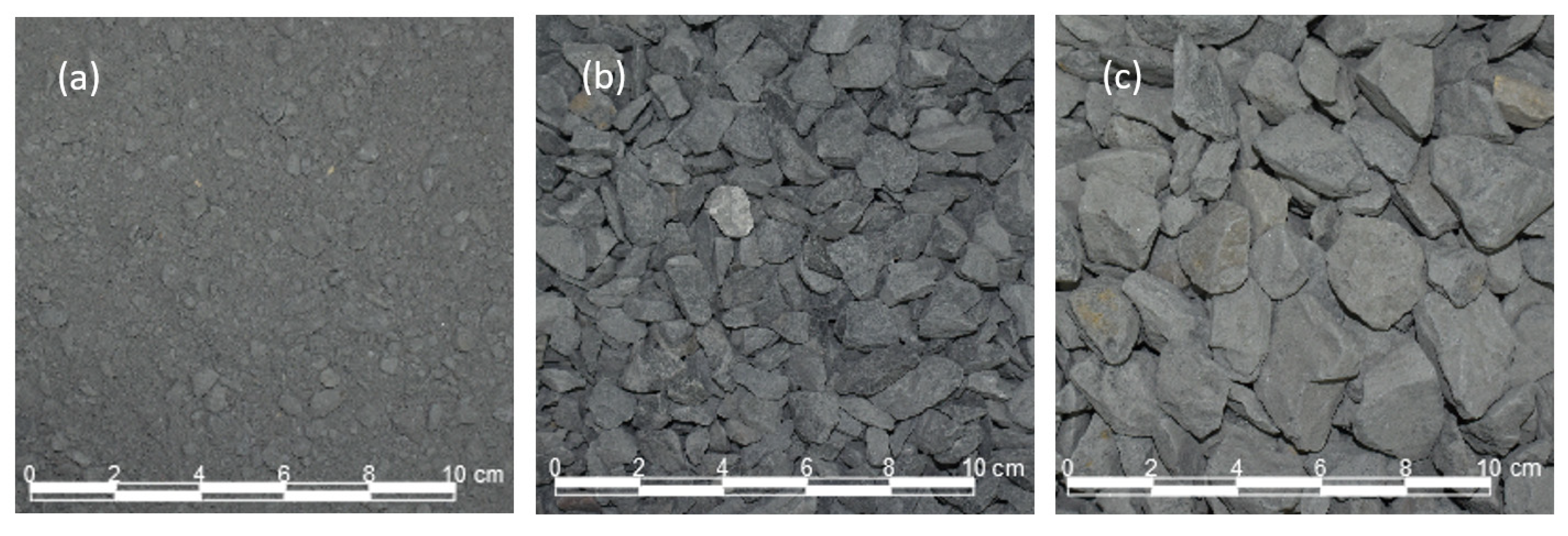
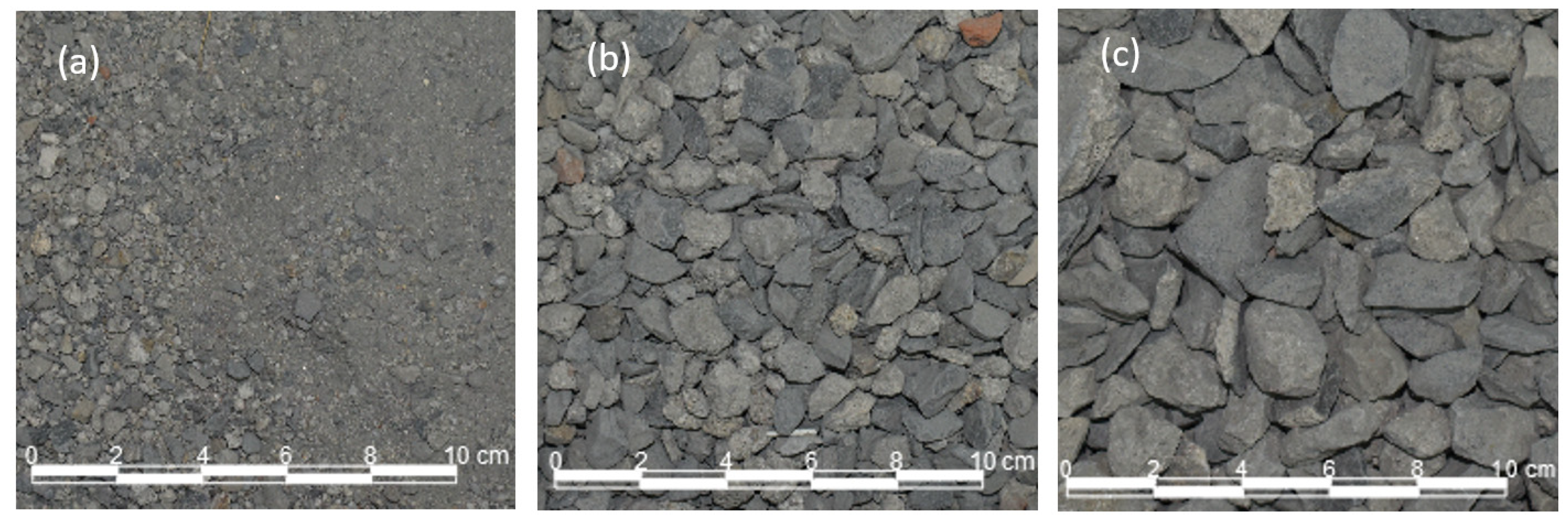
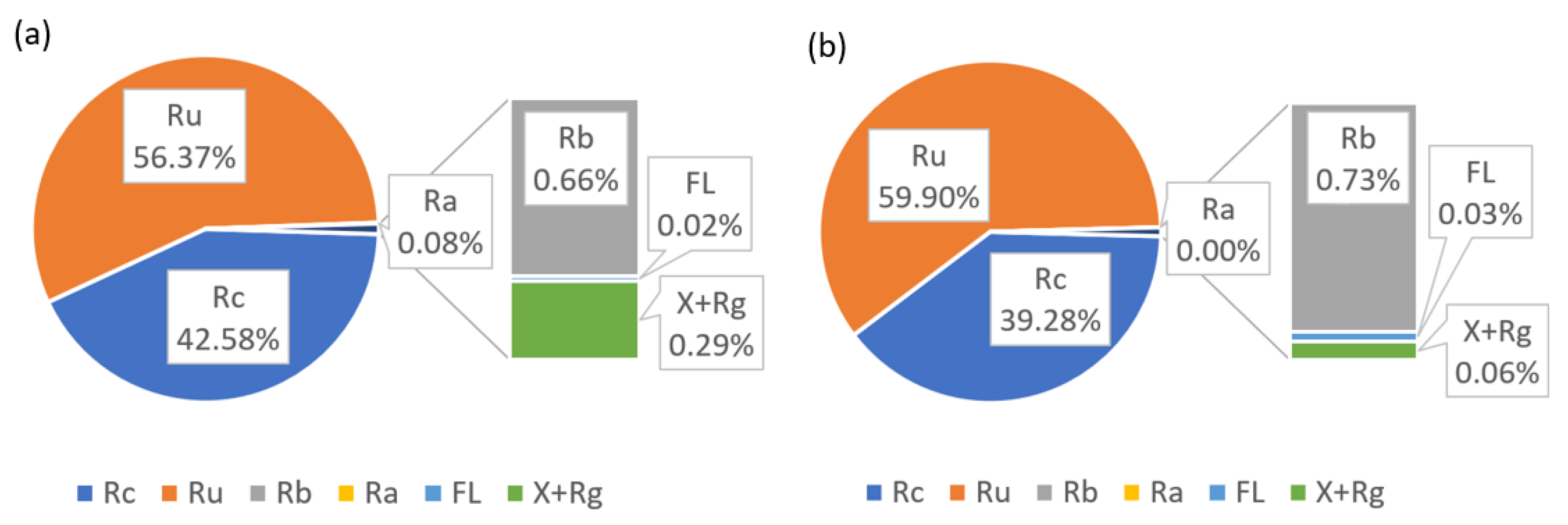
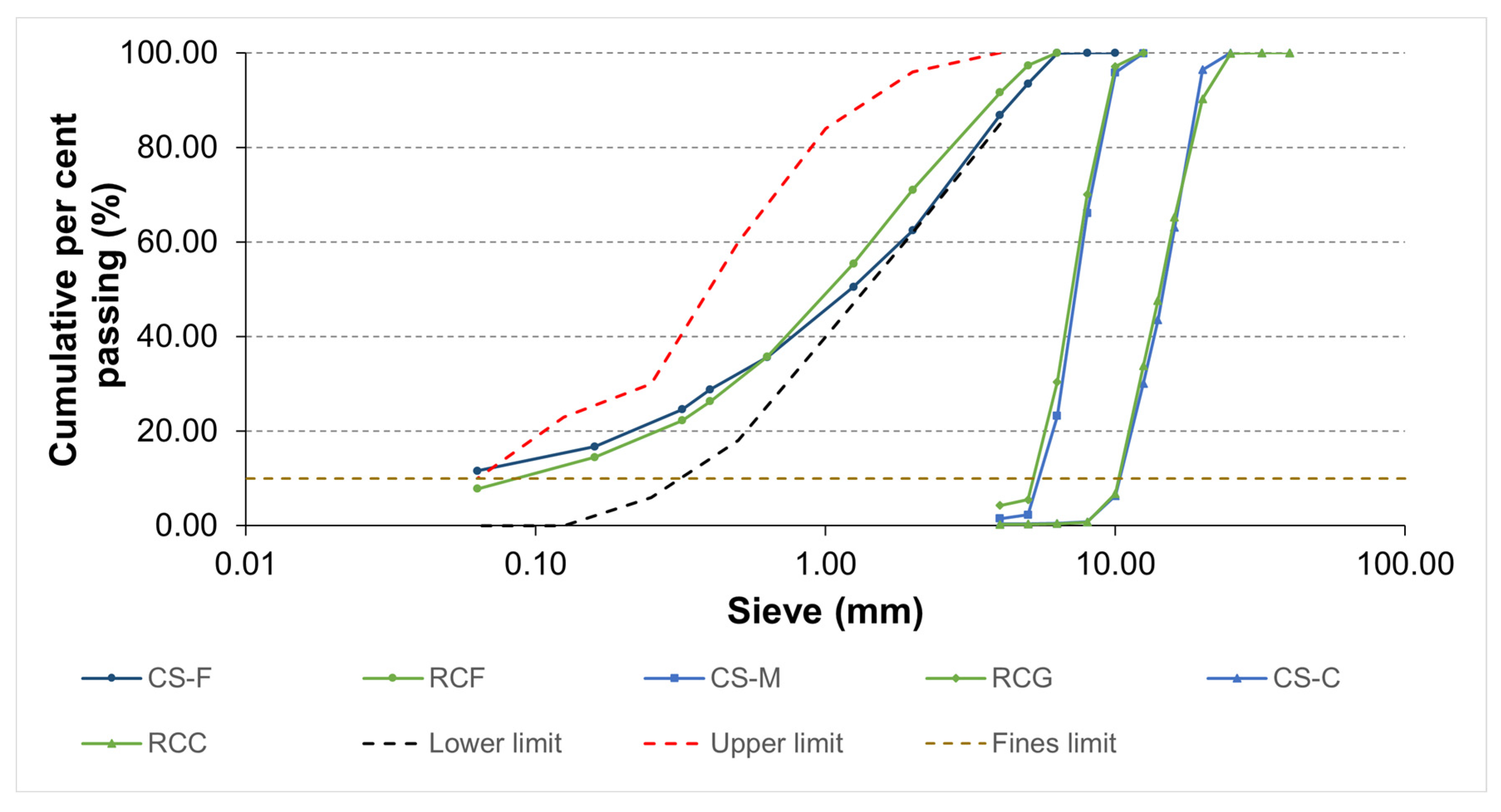
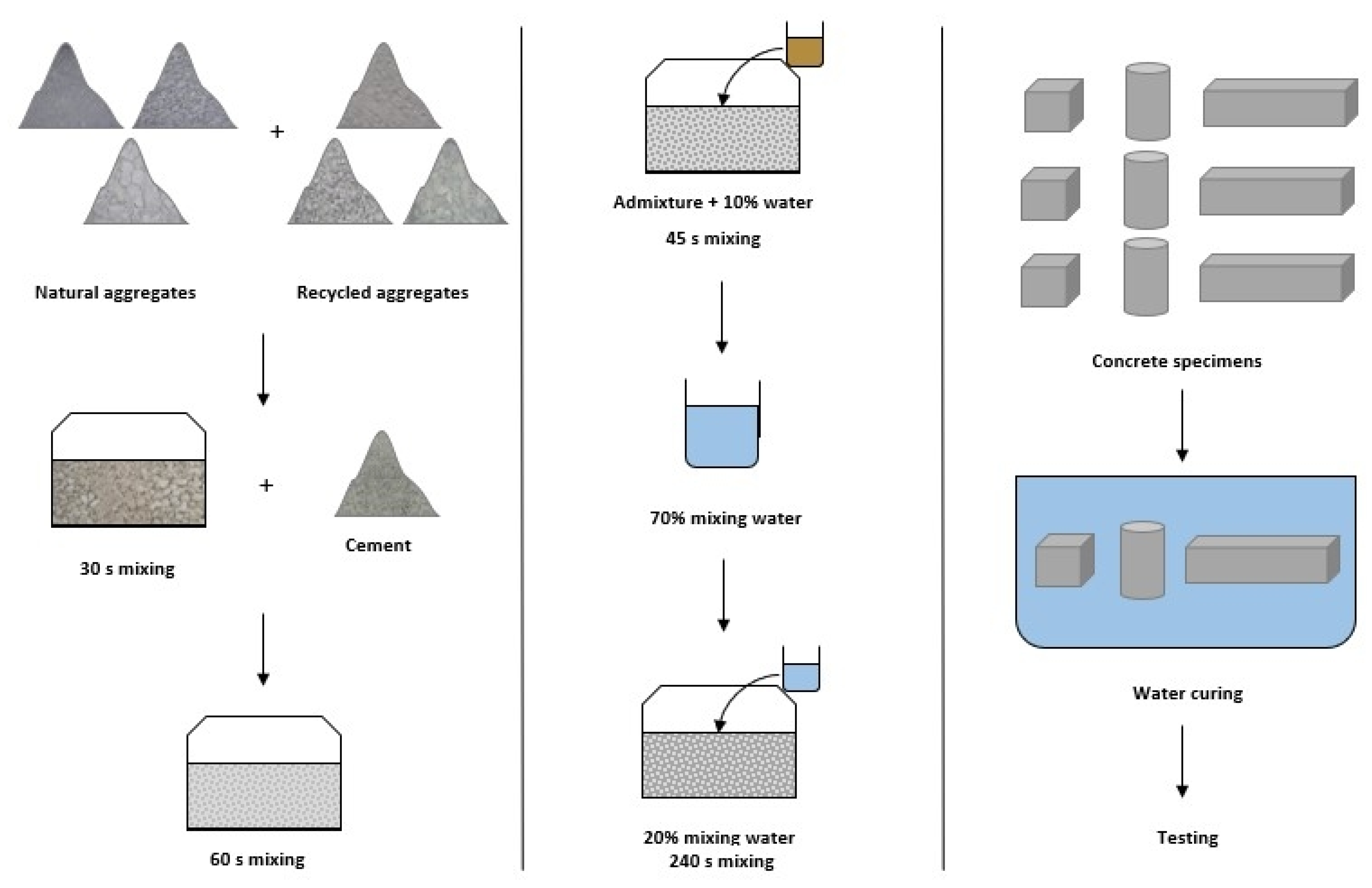
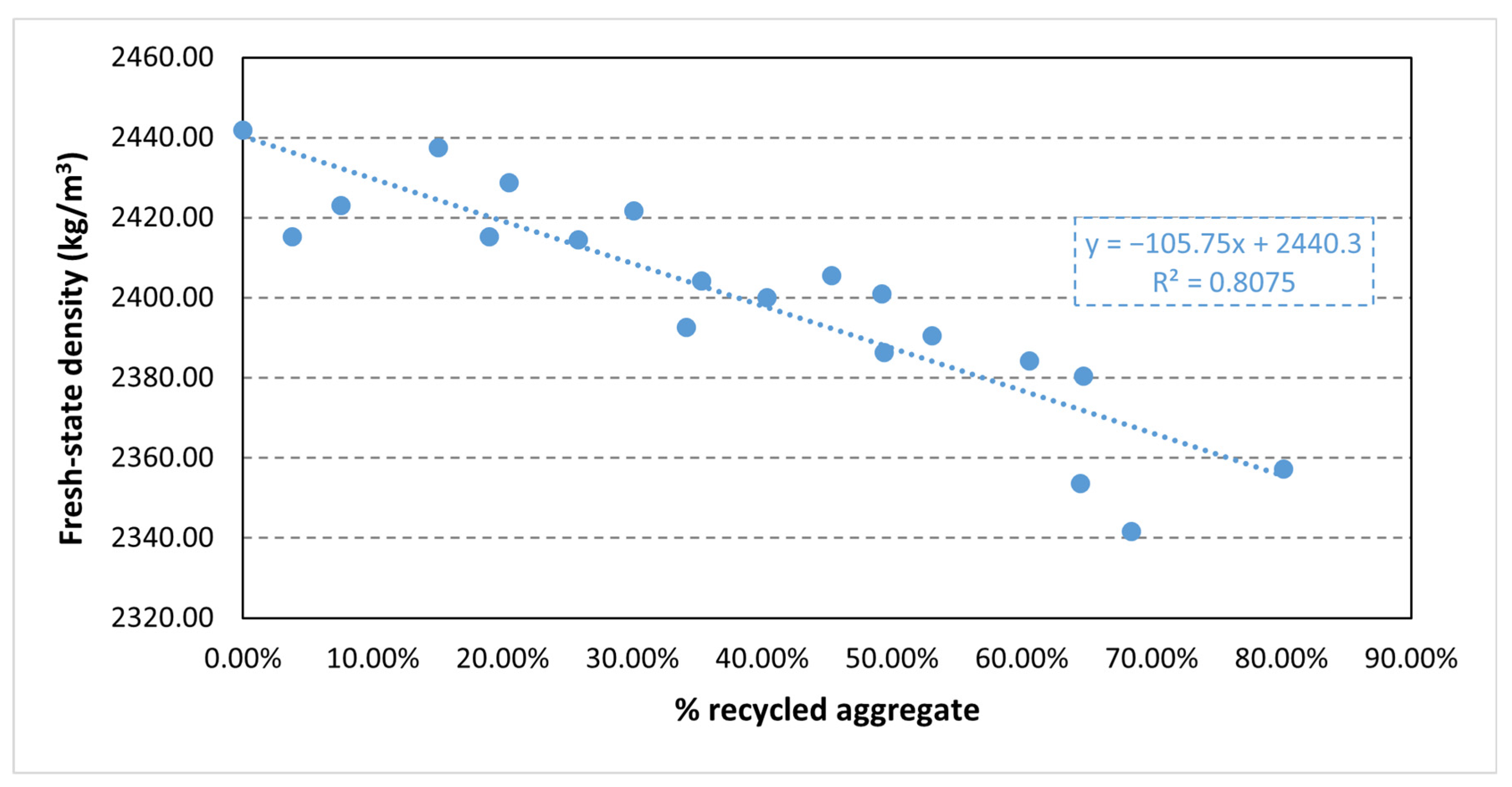
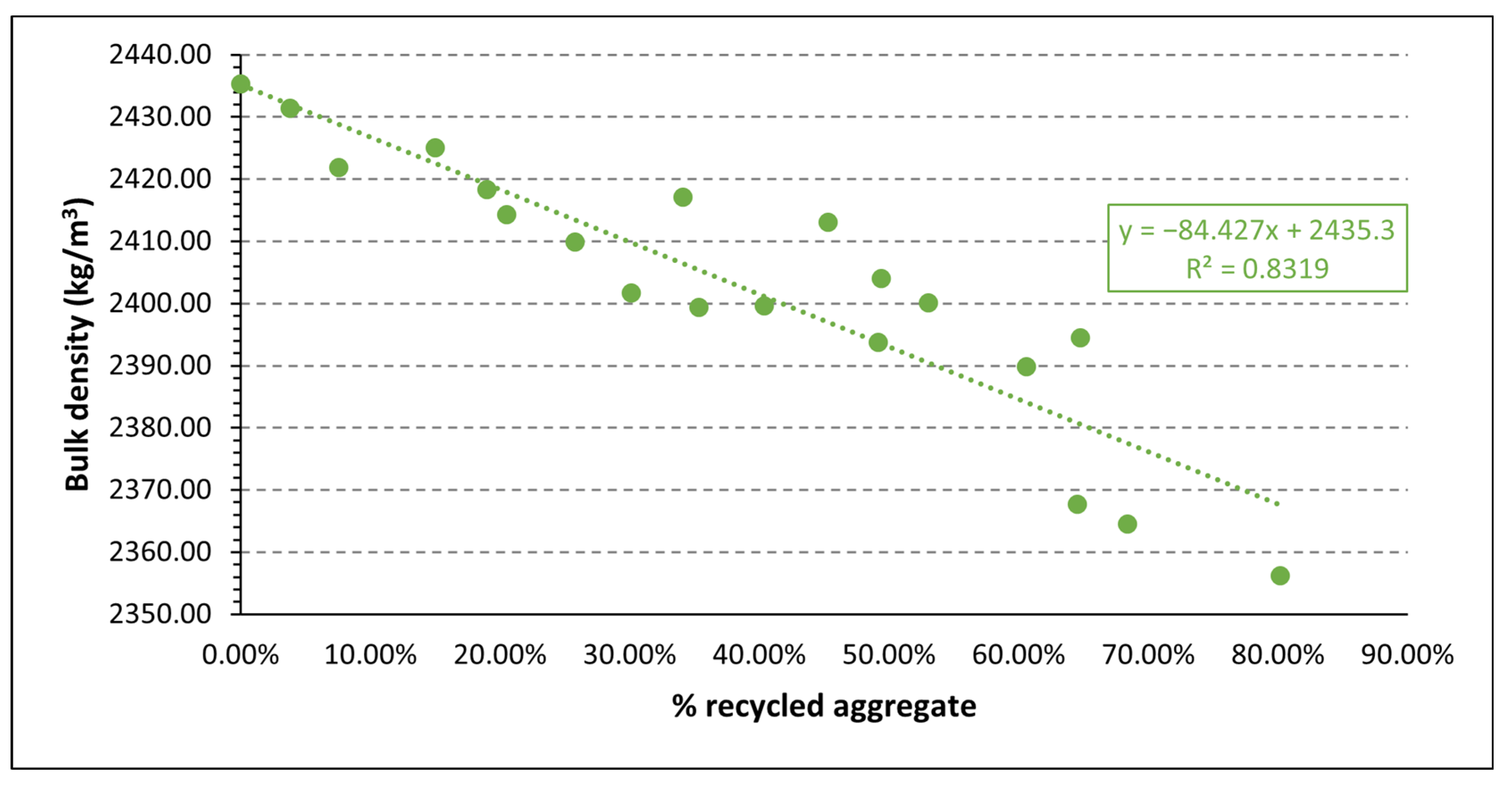




| Country | Aggregate Type | Fraction | Max. Substitution (%) | Concrete Type | Strength Class |
|---|---|---|---|---|---|
| Australia AS 1141.62/HB 155:2002 [11] | RCA (Class 1A) | Coarse | 30 | Structural | C40/50 |
| China GB/T-25177 [12] | RCA—Type I | Coarse | 100 | Structural | No limit |
| RCA—Type II | 30 | Structural | C40/50 | ||
| RCA—Type III | 30 | Structural | C25/30 | ||
| RCA—Type I | Fine | 100 | Structural | C40/50 | |
| RCA—Type II | 30 | Structural | C25/30 | ||
| RCA—Type III | 30 | Non structural | - | ||
| Korea KS-F-2573 [13] | RCA | Coarse | 30 | Structural | 27 MPa |
| Coarse + Fine | 30 | Non structural | 21 MPa | ||
| Hong Kong CS-3:2013/HKBD 2009/WBTC-No. 12 [14] | RCA | Coarse | 20 | Structural | C25/30–C35/45 |
| 100 | Non structural | ||||
| Japan JIS-5021 [15]/JIS-5022 [16]/JIS-5023 [17] | RCA—HQ | Coarse | 100 | Structural | C45/55 |
| Fine | 100 | ||||
| RCA—MQ | Coarse | 100 | Structural | C35/45 | |
| Fine | 100 | ||||
| RCA—LQ | Coarse | No limit | Non structural | - | |
| Fine | |||||
| Belgium PTV 406-2003 [18]/NBN B 15-001 [19] | RCA—Type A | Coarse | 50, 30, 20 | Structural | C30/37 |
| Germany DIN 4226-101, DAfStb [20] | RCA—Type A | Coarse | 45, 35, 25 | Structural | C30/37 |
| Italy NTC-2008 [21] | RCA 1 | Coarse | 30 | Structural | C30/37 |
| 60 | C25/30 | ||||
| RCA 2 | 15 | C45/55 | |||
| Denmark DS 2426/DCA No. 34 [22] | RCA 1 | Coarse | 100 | Structural | C40/50 |
| RCA 2 | Coarse and fine | 100 | |||
| Netherlands NEN-5905 [23] | RCA | Coarse | 20 | Structural | C55/67 |
| Portugal LNEC-E471 [24] | RCA 1 | Coarse | 25 | Structural | C40/50 |
| Switzerland MB-2030 [25] | RCA 1 | Coarse | 100 | Structural | No limit |
| RCA 2 | 100 | ||||
| United Kingdom BS 8500-2 [26] | RCA | Coarse/Fine | 20 | Structural | C40/50 |
| France NF P 18-545 [27] | RCA 1 | Coarse | 60, 30, 20 | Structural | No limit |
| RCA 2 | 40, 15 | ||||
| Spain Structural Code [28] | RCA | Coarse | 20 | Structural | C40/50 |
| 100 | Non structural | - | |||
| EN 206 [29] | RCA | Coarse | 50, 30 | Structural | No limit |
| RILEM | RCA | Coarse | 100 | Structural | C50/60 |
| Brazil NBR 15116 [30] | RCA | Coarse/Fine | 100 | Non structural | - |
| Property [Standard] | CS-F | RCF | CS-M | CS-C | RCG | RCC | EN 12620 |
|---|---|---|---|---|---|---|---|
| Density (Mg/m3) [46] | 2.82 | 2.79 | 2.78 | 2.77 | 2.72 | 2.73 | - |
| Sorptivity (wt%) [46] | 1.18 | 4.42 | 0.88 | 0.78 | 5.40 | 3.63 | <5 |
| Fine equivalent (wt%) [47] | 73 | 61 | - | - | - | - | >70 * |
| LA coefficient (wt%) [48] | - | - | 16 | 18 | 27 | 27 | ≤40 |
| Flakiness index (wt%) [49] | - | - | 20.36 | 24.79 | 16.08 | 20.85 | <35 |
| Water-soluble chlorides (wt%) [50] | <0.01 | <0.05 | |||||
| Acid soluble sulphates (wt%) [50] | <0.002 | <0.80 | |||||
| Total sulphates (wt%) [50] | <0.001 | <1 | |||||
| Mix | Components (kg/m3) | |||||||
|---|---|---|---|---|---|---|---|---|
| NS | RS | NG-M | NG-C | RG-M | RG-C | Cement | Water | |
| HP | 732.36 | 0.00 | 382.96 | 766.69 | 0.00 | 0.00 | 400.00 | 193.03 |
| HR-0+10 | 655.65 | 70.59 | 380.95 | 762.65 | 0.00 | 0.00 | 400.00 | 195.20 |
| HR-0+20 | 581.26 | 140.81 | 379.94 | 760.63 | 0.00 | 0.00 | 400.00 | 197.40 |
| HR-0+50 | 360.4 | 349.21 | 376.92 | 754.58 | 0.00 | 0.00 | 400.00 | 203.93 |
| HR-25 | 724.65 | 0.00 | 284.20 | 568.96 | 92.01 | 186.72 | 400.00 | 197.37 |
| HR-25+10 | 648.72 | 109.24 | 282.69 | 565.94 | 91.52 | 185.72 | 400.00 | 202.36 |
| HR-25+20 | 576.64 | 218.48 | 282.69 | 565.94 | 91.52 | 185.72 | 400.00 | 206.34 |
| HR-25+50 | 358.47 | 347.35 | 281.18 | 562.91 | 184.73 | 281.18 | 400.00 | 209.38 |
| HR-50 | 716.94 | 0.00 | 187.45 | 375.27 | 182.06 | 369.46 | 400.00 | 203.86 |
| HR-50+10 | 643.51 | 108.37 | 186.95 | 374.26 | 181.57 | 368.47 | 400.00 | 207.72 |
| HR-50+20 | 572.01 | 216.73 | 186.95 | 374.26 | 181.57 | 368.47 | 400.00 | 211.67 |
| HR-50+50 | 354.62 | 343.61 | 185.43 | 371.24 | 180.10 | 365.49 | 400.00 | 214.55 |
| HR-75 | 711.16 | 0.00 | 92.97 | 186.12 | 270.88 | 549.72 | 400.00 | 209.18 |
| HR-75+10 | 638.31 | 68.72 | 92.72 | 185.62 | 270.15 | 548.23 | 400.00 | 211.29 |
| HR-75+20 | 567.38 | 137.44 | 92.72 | 185.62 | 270.15 | 548.23 | 400.00 | 213.49 |
| HR-75+50 | 349.80 | 338.94 | 91.46 | 183.10 | 266.48 | 540.79 | 400.00 | 219.48 |
| HR-100 | 701.52 | 0.00 | 0.00 | 0.00 | 356.29 | 723.03 | 400.00 | 214.20 |
| HR-100+10 | 627.90 | 67.60 | 0.00 | 0.00 | 356.29 | 723.03 | 400.00 | 216.15 |
| HR-100+20 | 556.59 | 134.83 | 0.00 | 0.00 | 353.35 | 717.07 | 400.00 | 218.19 |
| HR-100+50 | 345.94 | 335.21 | 0.00 | 0.00 | 351.39 | 713.10 | 400.00 | 224.40 |
| Property | Standard | Sample Size (cm) | NS/M | Testing Age (Days) |
|---|---|---|---|---|
| Fresh state | ||||
| Density | EN 12350-6 [56] | Evaluated during the manufacturing process | ||
| Entrained air | EN 12350-7 [57] | |||
| Consistency | EN 12350-2 [58] | |||
| Hardened state | ||||
| Density | EN 12390-7 [59] | 15 × 15 × 15 | 3 | 28 |
| Compressive strength | EN 12390-3 [60] | 15 × 15 × 15 | 9 | 7, 28, 90 |
| Flexural strength | EN 12390-5 [61] | 10 × 10 × 40 | 3 | 28 |
| Water penetration under pressure | EN 12390-8 [62] | Ø15 × 30 | 3 | 28 |
| Contrast Type | Compressive | Flexural | Water under Pressure | ||
|---|---|---|---|---|---|
| 7 Days | 28 Days | 90 Days | |||
| Bartlett | 0.456 | 0.803 | 0.381 | 0.605 | 0.075 |
| Shapiro–Wilk | 0.237 | 0.627 | 0.556 | 0.231 | 0.532 |
| Mix | Slump (mm) | Entrained Air (Vol. %) |
|---|---|---|
| HP | 82.8 | 1.63 |
| HR-0+10 | 65.0 | 1.58 |
| HR-0+20 | 75.0 | 1.60 |
| HR-0+50 | 80.0 | 1.68 |
| HR-25 | 78.0 | 1.66 |
| HR-25+10 | 77.5 | 1.78 |
| HR-25+20 | 77.1 | 1.74 |
| HR-25+50 | 87.0 | 1.80 |
| HR-50 | 89.0 | 1.66 |
| HR-50+10 | 82.0 | 1.66 |
| HR-50+20 | 60.0 | 1.82 |
| HR-50+50 | 77.5 | 1.74 |
| HR-75 | 66.3 | 1.73 |
| HR-75+10 | 90.0 | 1.60 |
| HR-75+20 | 75.0 | 1.73 |
| HR-75+50 | 92.5 | 1.68 |
| HR-100 | 72.0 | 1.82 |
| HR-100F10 | 90.0 | 1.90 |
| HR-100F20 | 90.0 | 1.90 |
| HR-100F50 | 80.0 | 1.90 |
| Parameter | Compressive | Flexural | Water under Pressure | ||
|---|---|---|---|---|---|
| 7 Days | 28 Days | 90 Days | |||
| µ11 | 45.27 | 55.20 | 60.53 | 7.12 | 4.45 |
| α2 | 1.00 | −2.87 | NS | NS | NS |
| α3 | NS | −3.84 | −5.12 | −0.42 | 5.98 |
| α4 | −1.13 | −3.89 | −1.97 | −0.49 | 3.38 |
| α5 | NS | −3.49 | −3.28 | −0.66 | NS |
| β2 | 1.18 | NS | −2.12 | NS | −2.51 |
| β3 | NS | −1.56 | −2.28 | NS | NS |
| β4 | −2.64 | −6.33 | −5.39 | −0.25 | NS |
| αβ22 | −3.60 | 3.53 | 3.62 | No interaction | 3.54 |
| αβ32 | −2.72 | 3.57 | 4.44 | −3.28 | |
| αβ42 | −1.44 | 4.24 | 2.78 | NS | |
| αβ52 | NS | NS | NS | NS | |
| αβ32 | 1.51 | 2.47 | NS | NS | |
| αβ33 | −2.71 | 2.36 | 4.32 | NS | |
| αβ43 | 3.96 | NS | NS | NS | |
| αβ53 | NS | NS | NS | NS | |
| αβ23 | −2.80 | 6.81 | NS | NS | |
| αβ33 | 5.34 | 6.30 | 7.55 | −4.83 | |
| αβ43 | NS | 5.64 | NS | NS | |
| αβ53 | NS | 2.79 | 2.72 | NS | |
| Mix | Average Depth (mm) | Maximum Depth (mm) |
|---|---|---|
| HP | 4.45 | 14.54 |
| HR-0+50 | 5.35 | 9.96 |
| HR-25 | 5.25 | 9.09 |
| HR-25+10 | 6.28 | 16.06 |
| HR-25+20 | 5.50 | 12.58 |
| HR-25+50 | 5.81 | 11.43 |
| HR-50 | 9.51 | 14.64 |
| HR-50+10 | 4.64 | 9.48 |
| HR-50+20 | 8.27 | 17.94 |
| HR-50+50 | 6.49 | 11.44 |
| HR-75 | 7.83 | 15.02 |
| HR-75+10 | 5.32 | 10.17 |
| HR-75+20 | 7.53 | 14.78 |
| HR-75+50 | 6.91 | 12.50 |
| HR-100 | 6.21 | 12.97 |
| HR-100+50 | 6.80 | 13.87 |
Disclaimer/Publisher’s Note: The statements, opinions and data contained in all publications are solely those of the individual author(s) and contributor(s) and not of MDPI and/or the editor(s). MDPI and/or the editor(s) disclaim responsibility for any injury to people or property resulting from any ideas, methods, instructions or products referred to in the content. |
© 2024 by the authors. Licensee MDPI, Basel, Switzerland. This article is an open access article distributed under the terms and conditions of the Creative Commons Attribution (CC BY) license (https://creativecommons.org/licenses/by/4.0/).
Share and Cite
Plaza, P.; Sáez del Bosque, I.F.; Sánchez, J.; Medina, C. Recycled Eco-Concretes Containing Fine and/or Coarse Concrete Aggregates. Mechanical Performance. Appl. Sci. 2024, 14, 3995. https://doi.org/10.3390/app14103995
Plaza P, Sáez del Bosque IF, Sánchez J, Medina C. Recycled Eco-Concretes Containing Fine and/or Coarse Concrete Aggregates. Mechanical Performance. Applied Sciences. 2024; 14(10):3995. https://doi.org/10.3390/app14103995
Chicago/Turabian StylePlaza, Pablo, Isabel Fuencisla Sáez del Bosque, Javier Sánchez, and César Medina. 2024. "Recycled Eco-Concretes Containing Fine and/or Coarse Concrete Aggregates. Mechanical Performance" Applied Sciences 14, no. 10: 3995. https://doi.org/10.3390/app14103995






